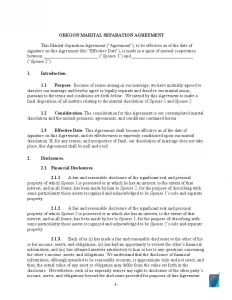Oregon Marital Settlement (Divorce) Agreement and Legal Separation
Any relationship has disagreements and misunderstandings, especially the relationship between husband and wife. Despite their shared views, values, and priorities, spouses may feel distrust, suspicion, and resentment toward each other. Therefore, some married couples in Oregon sign a marital agreement to set rules regulating their relationships.
The marital agreement is a legal document signed by people planning to marry. It determines the property rights and obligations of the spouses, both in marriage and after its dissolution. Since this agreement is a bilateral transaction, the will of the two parties is necessary—it is a prerequisite. No one should force you to sign the marital contract, much less threaten you with violent actions.
The marriage agreement can be drawn up both before the wedding and for the entire time that persons are married. If its conclusion links with the registration of the marriage, it becomes valid at this time. The second way excludes the wedding. It already provides for the married couple. A notary public agent certifies this document after explaining the spouses’ rights and obligations. This specialist also warns them about the legal consequences of its conclusion. In general, the marital agreement has many advantages, disadvantages, and features of conclusion and termination.

Build Your Document
Answer a few simple questions to make your document in minutes
Save and Print
Save progress and finish on any device, download and print anytime
Sign and Use
Your valid, lawyer-approved document is ready
The Oregon marital agreement is an effective tool for regulating the division of property after the divorce. It defines the conditions, rights, and obligations of the spouses, their financial shares, and assets. Besides, the contract sets out the requirements for divorce in the presence of a minor child. Undoubtedly, the marriage contract is not a mandatory requirement in this state. However, it may speed up the divorce process and minimize risks and disagreements.
How does the conclusion of the marital agreement begin? Firstly, with discussions and lengthy negotiations to eliminate all disputes and nuances. Next, provide reports on your current finances, debts, and expenses. Do not hide this information because lying will lead to intractable contradictions. Remember that the conclusion and official confirmation of this document is mandatory. Otherwise, you risk huge fines or even enforcement action.
The agreement also controls material and temporary support for spouses, child support, and payment conditions. Finally, it addresses the division of property, transport, and household items. Therefore, it is advisable to seek help from an intermediary or a lawyer. These highly qualified specialists will help you minimize costs, save your nerves, and calmly complete the divorce process. In any case, help will not hurt. In Oregon, an authorized judge issues the final verdict on divorce. Thanks to intermediaries, most divorces end successfully.
Features of a Marital Settlement Agreement
Regardless of the state of the United States, the marital settlement agreement includes several irreplaceable elements and features. Oregon is no exception to the rule.
Basic Information
In this section, the spouses append their signatures and date the marriage contract. Specify the first and last name and direct information about the children. All the information will help settle the divorce process following the laws, so do not withhold it to avoid difficulties.
Conditions, Rights, and Financial Position
It is no secret that the marital contract establishes the rights and obligations of each spouse. Read them carefully. There is a column about the current financial situation, income, expenses, and debts. This section also requires one of the spouses to have lived in the state for at least six months. It is the only way to apply.
Support
It is sometimes impossible to avoid the need for financial support. Specify the terms of its provision.
Do not forget to write the date and signature at the end of the agreement to confirm your intentions officially. If you have a shared child, please provide the necessary information. You may get married after the divorce at any time of the day or year—everything depends on your preferences. We suggest that you use our software and templates to complete and sign the marital settlement contract.
Oregon Divorce and Separation Laws
Any agreement in Oregon links with the local laws and regulations. Therefore, this state has a Law on the fair division of property (see Chapter 107, Sections 005-452). Read the information below carefully.
Grounds for Divorce
Unlike other American states, in Oregon, you can get a divorce without guilt. Neither party must prove that the other is guilty of something. The grounds for divorce are irreconcilable differences, quarrels, and a lack of common interests and values. For more information, see section (§ 107.025).
Alimony Payments and Child Support
There are some cases where the court orders the payment of alimony as temporary assistance to one of the spouses for an indefinite period. To make such a ruling, the judge considers such factors as the length of the marriage, the state of health, and age. Other factors include the ability to earn, the current financial situation, and the standard of living. If there are children, the court considers both the guardianship obligations and the issues of child maintenance.
The child support depends on each parent’s income since they are responsible for the minor’s life. For more information, read the principles of the Oregon Administrative Rules § 137-050.
Temporary Support
During the divorce process, the court can direct one spouse to support the other temporarily. Undoubtedly, each party has the opportunity to protect their rights and interests in the frame of the limits permitted.
General Rules
To apply for divorce, at least one of the spouses must have lived in the state for not less than six months. Furthermore, no law in Oregon prohibits or requires the separation of spouses. On average, the state authorities consider an application for divorce within two to six weeks before approving or declining.
Popular Local Marital Settlement Agreement Forms
It is better to determine the particulars of your divorce prior to the court hearing by using a divorce settlement agreement that covers various issues. Below are some of the most frequently searched documents for divorce settlement by state.
Property Issues
The most significant issue in the divorce process is the division of property. Regarding this issue, the court considers all property as jointly acquired, except gifts and inheritances. Therefore, all property is divided equally and fairly.
Below is a step-by-step plan of action and the specifics of divorce in Oregon.

Filing for Divorce in Oregon
Family life is not always perfect and happy. Unfortunately, some misunderstandings and contradictions lead to divorce. If your relationship is on the verge of collapse and cannot be salvaged, divorce peacefully. Either party has a right to file for divorce, citing various reasons— misunderstandings, disagreements, and irreconcilable values. Apply with a higher state court and follow the instructions. Use all available information to submit and fill out documents. Consider the specifics of the dissolution of marriages, especially if you have children together.
1. Apply for Divorce
The divorce process begins with the submission and completion of the application. The spouse filing for divorce for the convenience of the process is called the plaintiff, and the other party is the defendant. Undoubtedly, the specifics and duration of the divorce depend on the presence of children. In any case, act legally.
Here is a complete list of the necessary documents:
- Petition for divorce
- Registration for divorce
- Template about confidential information
- Statement of financial position and current assets
- Child support sheet and more
If the couple has a minor child, it is necessary to prescribe all the conditions for his upbringing and material support. If there are adults, they have the right to act as participants in the divorce process. No one should stop them.
2. Fill out Templates
Next, make copies of all documents and statements. Since there are two parties involved in the divorce process, the availability of copies will facilitate transparency in the case and the ability to respond to the defendant. Hand over the original forms to the clerk of a higher state court. They will review the forms and ask you to pay $301.
3. Communicate with the Respondent
The plaintiff should send copies of all previously submitted documents to the respondent face-to-face or through the sheriff. In the first case, it is necessary to hand them over to the respondent to sign. Consent to the divorce process is required. Send the documents to the court.
The second method is an official service. Send the documents to the defendant through the sheriff. In this case, a third party helps you establish contact. You can also mail the respondent’s place of residence or work. However, state law does not require them to sign the documents. They have the right to refuse to participate by signing a waiver of further appearance in court.
4. Provide the Required Response
There are three ways to resolve the divorce process in Oregon. First, both parties can resolve issues independently or with the help of an intermediary. In this case, the respondent submits a dissent to the request or decides not to file a response within 30 days of receipt. The plaintiff requires a decision in absentia.
If the defendant disagrees, the court accepts the case and considers it. The best solution is to discuss and negotiate with the parties. That way, the spouses agree on the terms and divorce peacefully.
5. Think of Default Solution
If the defendant does not respond within 30 days, submit the documents to the court. These include a petition for non-performance of duties, a statement of the court decision, an application for divorce, and much more. This solution does not require a court hearing. In this context, the judge independently makes a verdict and makes the general decision on the divorce.
6. Heed the Court Order
Unfortunately, there are many cases when the spouses disagree and have claims. Such cases are considered by an authorized judge, which may require the plaintiff and the defendant to attend the hearing or invite a mediator. Through the mediation mechanism, the parties negotiate or discuss the details of the divorce. In general, this simplifies the hearing procedure. As a result, the judge makes a decision and officially signs it. After the divorce, each party has the right to revert to their previous name.

Some other popular Oregon templates available for download and that can be modified in our hassle-free document constructor.
Other Marital Settlement Agreement Forms by State